By Richard Pagliaro | @Tennis_Now | Thursday, September 12, 2024
"I'm here to do something really fun and cool," Roger Federer told us of his inspiration for his new RF Collection collaboration with Wilson.
Photo credits: Wilson Racquet Sports and Jofe dos Santos
As a junior armed with his Wilson Pro Staff, Roger Federer sharpened his skills against an overwhelming opponent who never blinked and never missed.
Swinging with fluidity, the young Federer hit balls off the practice wall like a musician soloing in a concert hall.
Legend Line: Wilson and Federer Release New RF Collection
The teenage Federer was fine-tuning his explosive forehand coach Sven Groeneveld dubbed “the cliffhanger” because of the massive rotation the Swiss Maestro imparted creating the stealth shot that operated as optical illusion and devastating weapon.
“[He hit] a ball with so many RPMs that it would look like it was going out, but then at the last moment it would drop on the baseline,” Groeneveld told writer Christopher Clarey in his excellent Federer bio The Master. “Roger stayed for a long time with a traditional frame and could never have physically sustained the RPMs that needed to be generated to hit the cliffhanger or he would have had major injuries.”

In New York City last week, Federer revisited his wall-ball days stinging drives off the wall with the frame he helped design: his new Wilson RF01 Racquet.
The striking image of a Federer banner on the back wall looms over our shoulders as we sit on a green tennis bench to discuss Federer’s new RF Collection, a line of Wilson tennis equipment "inspired, designed and developed in partnership with Roger Federer" at Wilson’s flagship store at 594 Broadway in SoHo.
It’s a visual metaphor for what it must be like to be Federer these days. The 20-time Grand Slam champion’s past banner achievements are present wherever he goes.
Former world No. 1 Federer, who played with Wilson throughout his entire career, began collaborating with the brand in 2022 on a racquet meant for use for the final stage of his career. Federer’s main aim was to create a racquet that would “enhance your strengths” and that he could completely trust in critical stages like “a best friend.”
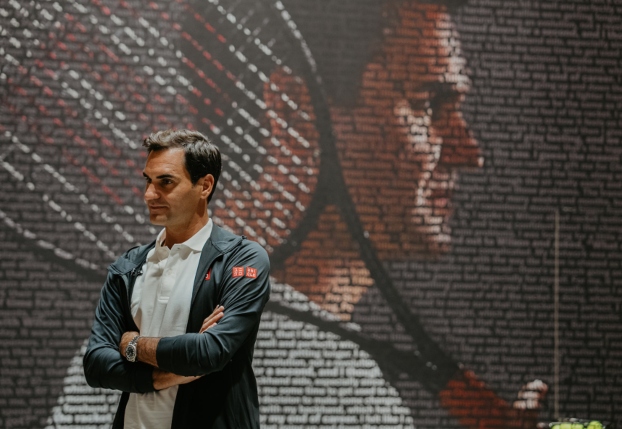
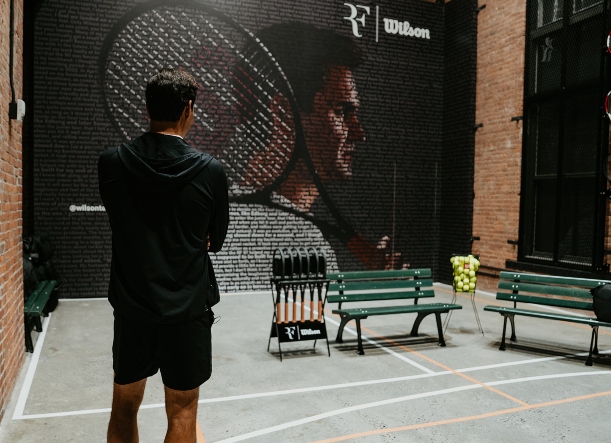
Though 2022 was Federer's final pro season, Wilson applied the eight-time Wimbledon winner's insights to develop the RF01, which the brand touts as "the most premium performance tennis racquet line.”
Tennis Now was among a select group of media invited to talk to the owner of 103 career titles—and the most famous initials in the sport—about his new RF collection collaboration with Wilson. The interview preceded a Federer Q&A with a group of fans who won a Wilson-sponsored contest to meet the Swiss Maestro.
Though his playing days are done, Federer is a prominent presence at the US Open. The man who famously flipped tennis’ all-white tradition into all black Manhattan night club cool unveiling his Darth Federer fashion remains tennis’ champion unifier.
US Open fans greeted Federer with a rousing and sustained ovation on his return to the US Open last week in a roaring response that reverberated throughout the grounds of the Billie Jean King National Tennis Center.
Visit any prominent tennis tournament in the world and you’ll find fans wearing the “RF” logo branded on baseball caps and t-shirts.
RF is one of tennis’ most iconic logos. Yet, when it comes to branding, Federer probably played the SABR as often as he deployed the iconic RF logo throughout his career.
In fact, when Federer launched his shoe collaboration with Swiss brand On, The Roger, On’s branding was more prominent than Federer's on the ivory shoe.
Branding this collaboration with Wilson the RF Collection came with a unique challenge: How do you balance two iconic logos on a single frame and do it with the elegance of a Federer forehand?
Sitting beside a black RF racquet bag, Federer told us fans should see the RF collection as his mission statement: “I’m all in.”
“I think I really wanted to—by bringing the RF brand into the colab to Wilson is to show the people: I’m all in,” Federer said. “I’m here. I’m here to do something really fun and cool.”
The man who captured five consecutive Wimbledon crowns between 2003-2007 looked tanned, relaxed, super-fit and genuinely excited to talk about the RF collection and how he plans to stay engaged tennis. Federer was in good spirits chatting with staffers and was at ease as people pulled out their phones to shoot photos as he signed the grips of several RF01 racquets right before our interview.
The father of two sets of twins—daughters Charlene Riva and Myla Rose and sons Lenny and Leo—Federer shared he spends much of his time these days doing various dad duties, preparing for the upcoming Laver Cup and continuing his work with his foundation.
The game-changing champion remains devoted humanitarian.
Twenty-one years ago, Federer launched the Roger Federer Foundation, which supports well-being and educational programs for underserved children in Southern Africa. Last September, Federer spoke to the United Nations on Investing in Education Systems for Sustainable Development and Children’s Wellbeing.
“I believe in the power of people. They might only need some initial empowerment,” Federer said of his foundation, which has helped more than 2 million children over the past two decades. “We know that a good education empowers children by allowing them to take their future into their own hands and play an active part in shaping it.”
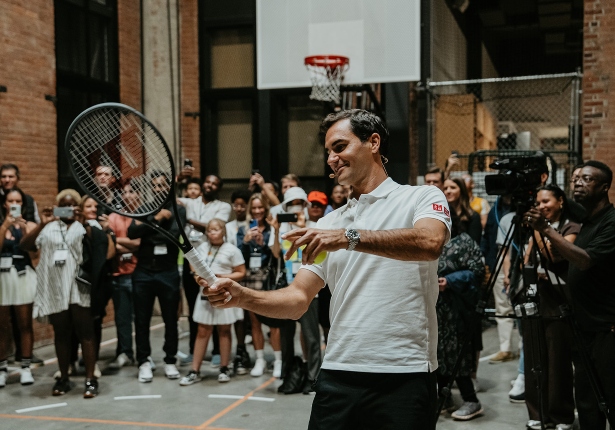
Thank you to Roger Federer for his time and willingness to share his ideas and to the Wilson Racquet Sports team and to Federer’s Team8 Manager, Tony Godsick, for their help setting up our Q&A.
A very special thank you to Jofe dos Santos of the Tennis Express team, who we ran into at a coffee shop on Broadway minutes before RF’s appearance, for taking some exquisite shots of Roger and kindly sharing them with us to publish for this interview.
Our Q&A with Roger Federer came nearly 20 years to the day after Federer delivered a masterful elegant thrashing to rival Lleyton Hewitt in the 2004 US Open final. That commanding performance may have been peak Federer Express at his exhilarating best.
Does Federer feel that was his best major match? We asked him in this Q&A.
This interview also came 20 years after we sat down with Federer for a one-on-one Q&A he did minutes before making his first speech before the United Nations in New York City back in 2004. You can revisit that 2004 interview we did with Federer here.
As an interview subject, Federer brings the same focus you see in stop-action photos of his famed forehand where his head remains riveted on the contact point even after the ball leaves his strings.
In conversation, Federer has a kind of relaxed intensity. He's engaging, focused and looks you directly in the eyes during our discussion of the RF Collection, his design inspiration, the evolution of racquets and strings and his future in tennis.
Tennis Now: Roger, what were the essential elements you needed from your racquet when you were playing?
In terms of the playability, what were the important elements you wanted to bring to the RF line for regular players who aren’t Roger Federer?
Roger Federer: To be honest, you don’t want to think about the racquet when you’re playing well, when you’re playing bad or when you’re in a tough spot. Because the racquet has to be your best friend. And it has to be there to support you.
And that’s what we’ve always talked about with Wilson: Do you trust your racquet at 5-all in the fifth set at 30-all?
Yes, I do.
That’s why I chose this racquet and that’s why I’m playing with it.
In terms of the playability, I think the racquet should enhance your strengths. And for me, I think when you look at the evolution of the racquets also, obviously I think my story is quite different from the nowadays players. Because I feel I went through quite a transition, you know?
The 90s, you know, which was still very different to where we are now.
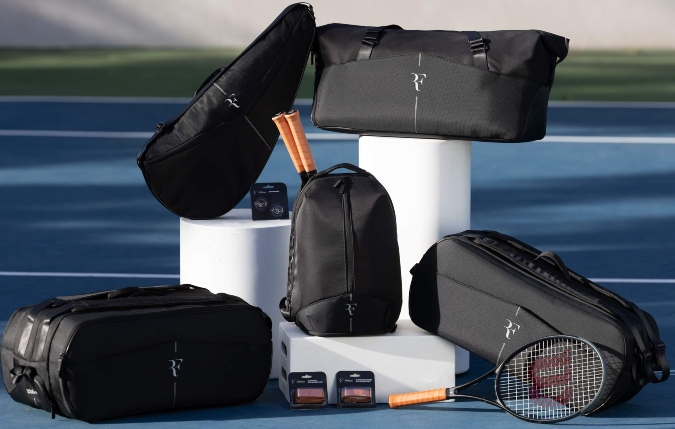
TN: And when you used the Pro Staff.
Roger Federer Yes, the Pro Staff, Pete’s racquet. It was super heavy, all gut. Now here we are today, now playing half and half but most of the players have switched to all polyester strings or Luxilon strings.
This evolution, I think, is quite interesting to tell.
So of course at the beginning it was to have a really heavy racquet. The court speeds were quick, balls were fast, guys were serving huge at the time, so you need something solid in your racquet that didn’t just break apart, you know?
And of course over time balls and courts have gotten much slower, which have allowed us to hit with the ball with way more topspin, the new racquet frames, livelier strings, the poly and stuff. So it’s been quite the evolution.
What I wanted, especially with the last racquet, was more racquet-head speed, more spin, so I could play easier angles.
TN: Can you talk a bit about the RF branding and the decision to use the RF branding on this collection?
Because it’s such an iconic brand logo. Also when it comes to RF, going back to when you created that did you imagine you would apply it to gear?
Roger Federer: So number one, I think this was really a nice, fun process. We all sat down and discussed: Should we do this or not?
How does Wilson feel about bringing RF in? How do I feel about putting RF on a racquet?
We have to both believe it’s the right thing to do.
I see it very much as creating a legacy as well. For me, staying within the game, hopefully inspiring a new generation of players, it’s a lovely way for me to stay involved in the game.
Because I’ve always said I would love to stay involved in the game and I think especially in grass roots through Wilson really resonated with me.
So when we built the racquet, we were like: Where is [the RF] going to be? There was a discussion: Should we put it on the strings?
I said: No, it has to be Wilson on the strings it’s so iconic and I’m so grateful for everything Wilson has done.
But maybe we can on the butt cap which is also very classic. You know, it’s like M or W? It’s now RF up or down. So we thought that would be fun for the people too. And obviously, we share the frame: Wilson on one side and RF on the other.
I think I really wanted to—by bringing the RF brand into the colab to Wilson is to show the people: I’m all in. I’m here. I’m here to do something really fun and cool.
I’ve been working with Wilson on the bags and grips all of that stuff in the past as well making sure we have the best balls, the best equipment. It was important to me that it was not just a racquet or just a grip, you know?
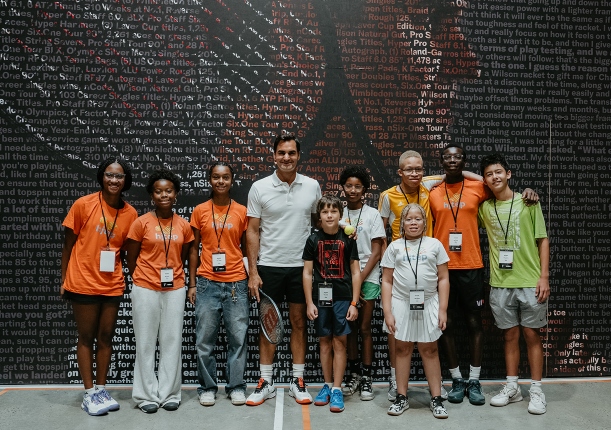
TN: Can you talk about the all-black cosmetic?
It's like when you brought Darth Federer to the US Open. What was the inspiration to go all black as opposed to things you’d done previously like the red-and-white?
Roger Federer: I think having the 97 was quite iconic, with the paint I thought it was quite beautifully that was based on the Tuxedo look. And then with the RF01, I didn’t want to go too far away from the black and just go completely colorful.
Also, we’re building a house at the moment and I’m very much into interior design and so forth. I just thought the fade is something we haven’t seen in the game yet. We have seen it on wall paper, cupboards, an ombre fade going. So I just thought: Is it possible for the machine to apply it [to the racquet]?
Wilson said: Let’s look into it. They were not very happy at the beginning how it was coming out. They improved that and then I also thought, you know the glare, the lighter piece at the top, that’s also how the idea came to me.
It’s to highlight I like the glare of the beautiful tennis swing.
You know how tennis is a beautiful sport. And I always want to highlight the beauty of our sport. It leaves that glare you see, but it’s not fully white to distract the other player. I think that would be a nice thing.
So that’s how we ended up with this color way, but obviously this is the very beginning. I’m sure we will create some different types of energy when it comes to color as well in the future, which I’m looking forward to do together.
I wanted to stay very classic and focus on the details you know with the pin stripe, the RF logos on the grip as well. And I think it came out really nicely.
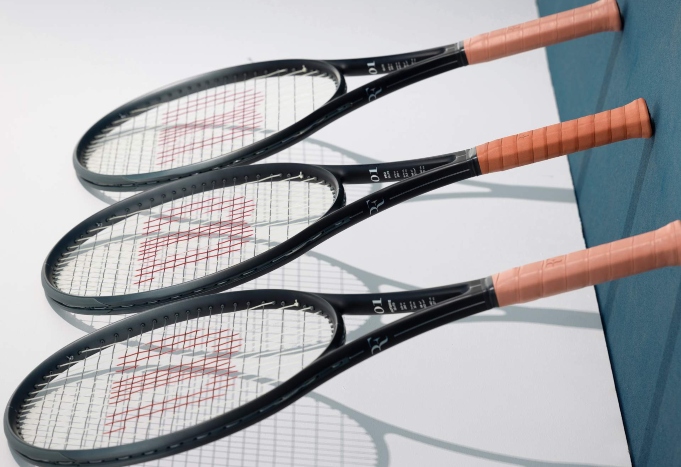
TN: You got a huge ovation from fans on your return to the US Open last night. You stood up at one point to acknowledge the fans. What did that reception feel like after all these years?
Reflecting on your US Open career, is there any one match or moment that stands out? Like for me it was when you beat Lleyton Hewitt in the 2004 final, two legends of the game and one guy just playing at such a high level. What stands out for you?
Roger Federer: I was a little bit nervous in the beginning. Because I was feeling like everyone was looking towards me and I was also worried just to see how was it going to be for me, the experience?
Because I really hadn’t been back to the US Open since I retired. So I got into the stadium and to see everyone so happy that I’m there. I’m happy they announced me very quickly because once I was in the stadium that was done. And then I could enjoy the evening.
The ovation I got was incredible.
You know, I love playing in New York. And I know the New York people, the New York tennis fans, know that. So that's why I think.
But to get an ovation like that, it’s always beautiful.
Nowadays, I don’t get it very often anymore because I’m driving kids around doing what I’m doing.
TN: Dad duties.
Roger Federer: Yeah, exactly. So it was a great moment and I was happy I came back to New York this year.
TN: And your best ever match in New York?
Roger Federer: Yeah, so I mean I agree with you. The Hewitt final was definitely [it].
Well, I think to play in the final and having two 6-0 sets, everything clicking at the highest of moments, I mean that’s what you train for. That’s what you wish for—always.
You know that it comes together at that very moment.
So I think it was a very important one because not only was he at his best, but I was at my best.
Also, Hewitt was kryptonite for me years before. I was having a really tough time against Lleyton. And I think for me to then overcome that and take my game to the next level and actually being able to really dominate that final was a bit of a shock to me.
But it showed me that I’m on such an incredible trajectory right now to be able to do it in New York for the very first time.
That was an incredible moment, definitely.
TN: Roger, thank you so much for your time and sharing your thoughts.
Roger Federer: Sure, good to see you again.